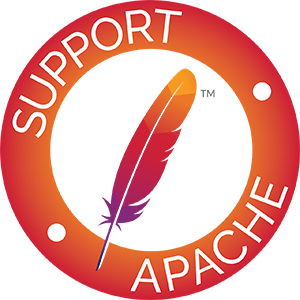Apache HTTP Server Version 2.4

Apache HTTP Server Version 2.4

Configuring Apache HTTP Server to listen on specific addresses and ports.

 Overview
Overview Changing Listen configuration on restart
Changing Listen configuration on restart Special IPv6 Considerations
Special IPv6 Considerations Specifying the protocol with Listen
Specifying the protocol with Listen How This Works With Virtual Hosts
How This Works With Virtual Hosts| Related Modules | Related Directives |
|---|---|
When httpd starts, it binds to some port and address on
the local machine and waits for incoming requests. By default,
it listens to all addresses on the machine. However, it may need to
be told to listen on specific ports, or only on selected
addresses, or a combination of both. This is often combined with the
Virtual Host feature, which determines how
httpd responds to different IP addresses, hostnames and
ports.
The Listen
directive tells the server to accept
incoming requests only on the specified port(s) or
address-and-port combinations. If only a port number is
specified in the Listen
directive, the server listens to the given port on all interfaces.
If an IP address is given as well as a port, the server will listen
on the given port and interface. Multiple Listen directives may be used to
specify a number of addresses and ports to listen on. The
server will respond to requests from any of the listed
addresses and ports.
For example, to make the server accept connections on both port 80 and port 8000, on all interfaces, use:
Listen 80 Listen 8000
To make the server accept connections on port 80 for one interface, and port 8000 on another, use
Listen 192.0.2.1:80 Listen 192.0.2.5:8000
IPv6 addresses must be enclosed in square brackets, as in the following example:
Listen [2001:db8::a00:20ff:fea7:ccea]:80
Overlapping Listen directives will result in a
fatal error which will prevent the server from starting up.
(48)Address already in use: make_sock: could not bind to address [::]:80
See the discussion in the wiki for further troubleshooting tips.
When httpd is restarted, special consideration must be made for
changes to Listen directives. During a restart, httpd keeps ports
bound (as in the original configuration) to avoid generating
"Connection refused" errors for any new attempts to connect to the
server. If changes are made to the set of Listen directives used
which conflict with the old configuration, configuration will fail
and the server will terminate.
For example, changing from configuration:
Listen 127.0.0.1:80
to the following may fail, because binding to port 80 across all addresses conflicts with binding to port 80 on just 127.0.0.1.
Listen 80
To have such configuration changes take effect, it is necessary to stop and then start the server.
A growing number of platforms implement IPv6, and APR supports IPv6 on most of these platforms, allowing httpd to allocate IPv6 sockets, and to handle requests sent over IPv6.
One complicating factor for httpd administrators is whether or
not an IPv6 socket can handle both IPv4 connections and IPv6
connections. Handling IPv4 connections with an IPv6 socket uses
IPv4-mapped IPv6 addresses, which are allowed by default on most
platforms, but are disallowed by default on FreeBSD, NetBSD, and
OpenBSD, in order to match the system-wide policy on those
platforms. On systems where it is disallowed by default, a
special configure parameter can change this behavior
for httpd.
On the other hand, on some platforms, such as Linux and Tru64, the
only way to handle both IPv6 and IPv4 is to use
mapped addresses. If you want httpd to handle IPv4 and IPv6 connections
with a minimum of sockets, which requires using IPv4-mapped IPv6
addresses, specify the --enable-v4-mapped configure option.
--enable-v4-mapped is the default on all platforms except
FreeBSD, NetBSD, and OpenBSD, so this is probably how your httpd was
built.
If you want httpd to handle IPv4 connections only, regardless of
what your platform and APR will support, specify an IPv4 address on all
Listen directives, as in the
following examples:
Listen 0.0.0.0:80 Listen 192.0.2.1:80
If your platform supports it and you want httpd to handle IPv4 and
IPv6 connections on separate sockets (i.e., to disable IPv4-mapped
addresses), specify the --disable-v4-mapped configure option. --disable-v4-mapped is the
default on FreeBSD, NetBSD, and OpenBSD.
The optional second protocol argument of
Listen
is not required for most
configurations. If not specified, https is the default for
port 443 and http the default for all other ports. The
protocol is used to determine which module should handle a request, and
to apply protocol specific optimizations with the
AcceptFilter directive.
You only need to set the protocol if you are running on non-standard
ports. For example, running an https site on port 8443:
Listen 192.170.2.1:8443 https
The Listen directive does not implement
Virtual Hosts - it only tells the
main server what addresses and ports to listen on. If no
<VirtualHost>
directives are used, the server will behave
in the same way for all accepted requests. However,
<VirtualHost>
can be used to specify a different behavior
for one or more of the addresses or ports. To implement a
VirtualHost, the server must first be told to listen to the
address and port to be used. Then a
<VirtualHost> section
should be created for the specified address and port to set the
behavior of this virtual host. Note that if the
<VirtualHost>
is set for an address and port that the
server is not listening to, it cannot be accessed.